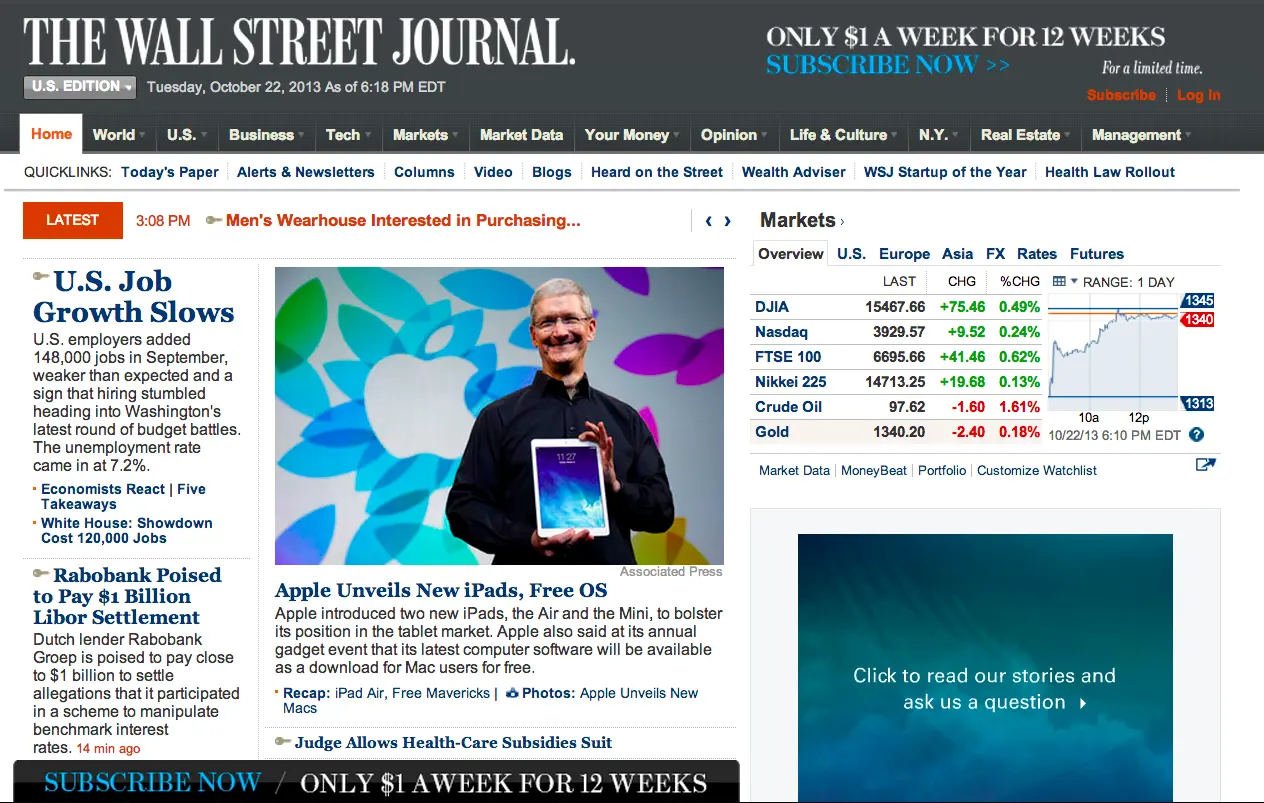Experiment Ideas for Publishers to Increase Online Subscriptions
While there is much discussion and data on how paywalls affect readers (e.g higher readership of free content sites like HuffPo and BuzzFeed), my concern is with the marketers at online publishers like The Wall Street Journal and The New York Times. How does the presence of a paywall affect a digital marketer? Here’s how: page consumption. Paywalls can present a real barrier to pageviews—one of the most vital metrics for marketers at media sites.

When Business Insider published a very long profile of Yahoo CEO Marissa Mayer in August (22,000 words and 8 webpages long) the media world was shocked—but not because of the content. Writers and bloggers were shocked that a piece of such quality longform journalism like this was available for the entire world to read free of charge—no subscription or dollars required. Considering the engagement numbers—243 comments, 14,000 recommendations on Facebook, 4,113 LinkedIn shares, and 4,259 tweets—it seems that not requiring subscription or payment to view this piece of content worked well for BI. It’s hard to say what the numbers would look like if BI had put this piece behind a paywall, but I hypothesize they would be lower.
The reality is that many publishers today do enact these artificial barriers. If you’ve tried to read an article online at The New York Times or Wall Street Journal in the past couple years, you’ve undoubtedly seen a paywall asking you to subscribe in order to continue reading.
While there is much discussion and data on how paywalls affect readers (e.g higher readership of free content sites like HuffPo and BuzzFeed), my concern is with the marketers at these online publishers. How does the presence of a paywall affect a digital marketer?
Here’s how: page consumption. Paywalls can present a real barrier to pageviews.
Digital marketers working for publishers in today’s evolving media landscape are striving to increase page consumption. They want readers to be so engaged with the content that they view a lot of it, thus either seeing lots of ads or subscribing to the channel to keep the quality stuff streaming to their inboxes. The more places a link to the piece exists, the more eyeballs will land on it, the more ad impressions, subscriptions, shares, etc.
The average reader in the US and the UK spends about 2-4 minutes a day reading online news sites so the digital marketer has a tough time as it is keeping people on site consuming content. Then throw a paywall on top of that number and it’s a whole new ballgame. Leading publishers are trying many different models to stay profitable and paywalls the most widely spread because they have worked. Digital subscriptions are on the rise at The New York Times; currently about 700,000 people subscribe to digital content.
A majority of the major historically-print-now-online publishers have taken to the paywall business model—either a “hard” wall where visitors cannot read any article until they subscribe, or a “soft” one where select content is viewable before a subscription is required. The Wall Street Journal was the first major newspaper to implement a paywall, making WSJ.com available to readers for $50 a month in 1997. Today they package online and print subscriptions together at a discounted rate. The New York Times has found considerable success around this model as well. Smaller newspapers are also experimenting—and finding success—with the format.
Advocates of paywalls insist that the publishers’ revenue model of the future relies on reader subscriptions. This model lends itself to the print distribution system where readers pay a subscription to get full access to content.
On the other side of the spectrum is USA Today, the third largest daily newspaper in the U.S. They are the only daily out of the 81 Gannett-owned daily papers that has decided against a paywall—for now anyway. Instead, USA Today operates with the ad-supported free content model whereby they present all content for free and derive revenue from advertising or other means. This model relies on the premise that free compelling content and a flood of visitors (pageviews) will attract advertising dollars.
Regardless of which model a publisher chooses, marketers tasked with increasing consumption of published content face challenges in driving pageviews, and lots of them. How does one increase online engagement if readers are being blocked from the very pages you want them to consume? What can a digital marketer do to keep those readers engaged and through the paywall?
Since not all paywalls are or should be created equal, it all comes down to A/B testing and optimization. Digital publishers need to implement serious testing strategies to learn more about what their readers want and how much they are willing to do to get it.
The possibilities of paywall structure are numerous. How permeable should it be? Should it be more of a hurdle than a wall? Should some content be available before a paywall? If so, how much? It’s unrealistic to expect anyone to come up with optimal decisions to these questions by gut and intuition alone. For publishers to be successful and profitable online, they should apply data gleaned from rigorous and focused testing.
Consider the homepage of any major publisher, like The Wall Street Journal for example. There are so many testable variables here. Notice they’re using a key symbol to indicate content behind the paywall. One quick test is trying different variations of that lock and seeing how it affects subscription signups or clicks on gated headlines. They can test the placement of gated articles. Should they be grouped together or dispersed around the homepage?

The homepage of the Wall Street Journal (wsj.com), rife with testable elements.
In the >next article of this three-part series on the role of testing on media sites, we dive deep into WSJ.com and discuss more test ideas they—or any publisher/website using a gate-for-content structure—can use to deliver more value to each and every reader that keeps them coming back for more.
